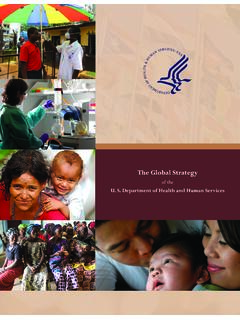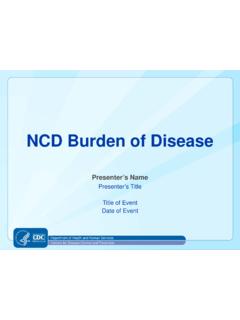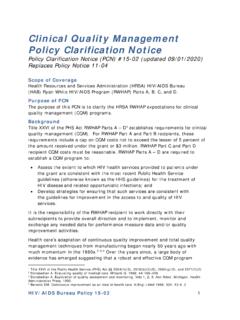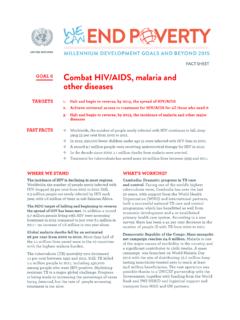Transcription of HIV Prevention with Adolescent Girls and Young Women …
1 HIV Prevention with Adolescent Girls and Young Women (AGYW). Geneva, 8-9 May 2018. SUMMARY OF DISCUSSIONS, RECOMMENDATIONS AND ACTION POINTS. Opening remarks Tim Martineau, UNAIDS DXD ai, thanked all participants for their attendance and highlighted the complementary roles of the different stakeholders present. He stressed that working towards agreement on geographic and demographic priorities, definitions of programme packages for AGYW. as well as ways to scale up and measure programme coverage for AGYW will be key as we move forward with an intensified effort towards comprehensive programme implementation. He also alluded to the timeliness of the meeting in terms of sending a signal to potential funders of HIV AGYW.
2 Programmes on how we jointly are ensuring alignment and harmonization to ensure the most impact for the investment in Prevention . There has been significant progress with the implementation of the 100-day plans as part of the global Prevention Coalition and that we now need to push forward in terms of the implementation of the Roadmap of which HIV with AGYW is one key pillar. Expected outcomes Expected outcomes of the meeting were: 1. A common understanding of geographical pattern of HIV incidence and the number of Adolescent Girls and Young Women at risk, and consensus on geographic priorities for HIV. Prevention programmes 2.
3 Agreement on standard service packages for different epidemiological settings programs, taking into account minimum needs and the scalability of existing projects 3. A better understanding of the role of different partners in supporting key policy and structural actions required for effective HIV Prevention and SRHR programmes among AGYW and their partners 4. Recommendations for strengthened approaches to monitoring and evaluation of HIV. Prevention among AGYW, including agreement on next steps to ensure monitoring against standard indicators and targets 5. Proposed steps to strengthen national stakeholder coordination mechanisms Reaching the highest incidence locations and populations Presentations by UNAIDS, PEPFAR, global Fund and UNICEF have been shared and are available in the meeting drop box: They provided an overview of HIV prevalence and incidence patterns based on a rapid review of DHS+ surveys followed by presentations on geographical prioritization from PEPFAR, global Fund and UNICEF colleagues, with a summary provided by BMFG.
4 Key points from the discussion included: HIV incidence and prevalence among AGYW have declined in many settings but are still high. There is opportunity for further increased socio-demographic focus of Prevention programmes based on a more granular analysis. Overall there seems to be good geographic alignment of donor funded partners programmes with HIV incidence locations, with key partners complementing each other in the selection of 1. districts, but there is still a wide range in coverage of national programmes (between 10 and 100 % of high incidence districts covered). In some countries like Uganda and Zimbabwe, geographic coverage of programmes is not fully aligned with areas with highest estimated incidence.
5 Some recent PHIA data suggests that HIV incidence among Women peaks in the 25-34 year age group, while there is often only limited programmatic focus on this age group. There are also challenges in West Africa, in countries like Ghana and DRC, as the extent of the epidemic among AGYW remains somewhat unclear. The existing UNAIDS AGYW incidence maps derived from spectrum estimates, will be updated based on new data, and countries will be engaged following the updated desk review. (presentation available in meeting drop box, folder 1). There is need to look at coverage in a more granular fashion, as there might be major gaps at sub district level which may be creating a false or skewed picture of coverage.
6 The issue of migration and programme coverage in border areas and other hotspots is also critical to be considered, as it might not be captured by current district level analyses. It is only partially clear whether and to what extent current programme intensity is aligned to incidence levels. Investing in the highest burden districts will be key to ensure maximum efficiency Proposed next steps Update sub-national incidence maps based on 2018 data (UNAIDS HQ). Review HIV AGYW incidence data in selected West African countries (UNAIDS HQ). Engage countries in dialogues around geo-spatial analysis of HIV incidence for AGYW & male partners and work towards developing a more granular mapping of high, very high and extremely high HIV incidence locations, including identification of hotspots (all partners, consultants).
7 At country-level, develop a consensus estimate of the number of locations and the number of Adolescent Girls , Young Women and male partners at high risk to be reached with programs (national HIV AGYW working groups). Within locations agree on whom to reach (age 15-24, or 15-29, male partners' profile age 20- 34 or different based on local factors , socio-demographic and behavioural aspects) based on demographic analysis and use of available risk assessment tool, and estimate numbers to be reached (local HIV and AGYW programmes and stakeholders). Update and refine tables of coverage of sub-national areas with HIV Prevention program components and Adolescent Girls , Young Women and male partner populations segments (national M&E staff).
8 O which locations are covered ;. o which sub-populations in these locations are covered ( by age and gender, in- school, out-of-school etc.);. o which components of the Prevention package are currently provided;. o who covers & funds which components and which sub-populations (government, PEPFAR, GF, bi-lateral, civil society). Based on improved and shared data, establish and address overlaps and gaps in the high, very high and extremely high incidence locations (M&E staff). Map investments/coverage from other sectors like education, broader SRH investments, major initiatives on GBV, child marriage and social protection starting with the high, very high and extremely high incidence locations (national HIV AGYW working group).
9 2. Basic platforms and minimum and expanded HIV Prevention packages An introductory presentation provided the background to HIV Prevention with AGYW as one pillar in the primary Prevention road map, and how the UNAIDS guidance document on combination Prevention among AGYW presents an options' menu to guide the definition of packages of interventions combining biomedical, behavioural and structural interventions. Key points from the discussion There is a need for the standardization of combination Prevention intervention packages for AGYW including male partners, to facilitate and ensure systematic implementation and the monitoring of progress in terms of increased program coverage and attributable impact.
10 There is also agreement that program package elements and intensity should differ according to incidence level. Harmonising approaches and key indicators among different agencies will have the potential for joint monitoring and efficiency gains. Standard health facility and school-based service platforms providing basic Sexual and Reproductive Health (SRH) and HIV Prevention services and comprehensive sexuality education (CSE) should be available country-wide but may not necessarily be HIV donor funded. Apart from basic SRH including family planning and CSE, wider non HIV-specific government programmes and development partner interventions may include social protection and economic empowerment measures to keep Girls in schools and programmes to address early marriage and gender-based violence.








